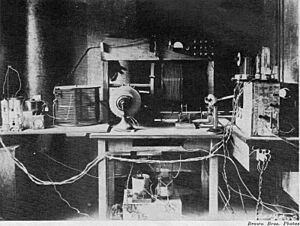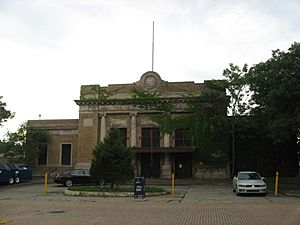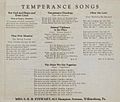Wilkinsburg, Pennsylvania facts for kids
Quick facts for kids
Wilkinsburg, Pennsylvania
|
|
|---|---|
|
Borough
|
|

Entrance to Wilkinsburg's municipal building and library, 605 Ross Avenue
|
|
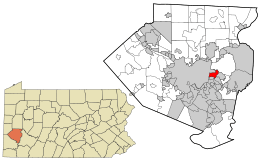
Location in Allegheny County and the U.S. state of Pennsylvania.
|
|
| Country | United States |
| State | Pennsylvania |
| County | Allegheny |
| Area | |
| • Total | 2.25 sq mi (5.83 km2) |
| • Land | 2.25 sq mi (5.83 km2) |
| • Water | 0.00 sq mi (0.00 km2) |
| Population
(2020)
|
|
| • Total | 14,349 |
| • Density | 6,368.84/sq mi (2,459.15/km2) |
| Time zone | UTC-5 (Eastern (EST)) |
| • Summer (DST) | UTC-4 (EDT) |
| FIPS code | 42-85188 |
Wilkinsburg is a borough located in Allegheny County, Pennsylvania, United States. It is part of the larger Pittsburgh metropolitan area. In 2020, about 14,349 people lived here. The borough was named after John Wilkins Jr., an important officer in the United States Army long ago.
Contents
History of Wilkinsburg
Wilkinsburg is in a special area of the Appalachian Plateau. This spot was important because many land and water travel routes met here. For thousands of years, Native Americans lived in this area.
Wilkinsburg is in a valley among hills, just east of where three big rivers meet: the Allegheny River, the Monongahela River, and the Ohio River. This valley made it easier to travel by land through the Appalachian Mountains. People could travel to and from cities like Philadelphia on the Atlantic coast. The nearby rivers also made water travel easy, connecting to the Mississippi River and the Gulf of Mexico. This made Wilkinsburg a key meeting point for travelers from different directions. A main road, now called Penn Avenue, was a vital path to the east.
In the early 1700s, European traders arrived. By the mid-1700s, France had built Fort Duquesne nearby. This area became a major battleground during the French and Indian Wars. Famous figures like George Washington and John Forbes helped build roads here. France lost control of the area in 1758. British forces then built Fort Pitt near the river junction.
After the American colonies declared independence in 1776, the Treaty of Paris (1783) made this area part of the new United States. In 1780, Pennsylvania and Virginia agreed on their border, and Wilkinsburg became part of Pennsylvania.
In the 1800s, mining and manufacturing grew. Many immigrants from Europe and African Americans from the Great Migration moved to the area. Wilkinsburg's population grew steadily during this time.
The Land Company of the Colony of Pennsylvania started selling land here in 1769. Andrew Levi Levy Sr. bought 266 acres and named it "Africa." In 1788, he sold it to William Thompson, a retired general. After Thompson died, the land went to Col. Dunning McNair.
In 1790, Dunning McNair planned a village called McNairstown on the "Great Road" (now Penn Avenue). In 1812, the village was officially named "Wilkinsburgh" to honor John Wilkins Jr., a friend of McNair.
Later, James Kelly became very involved in the area's growth. He bought McNair's land and helped with many community activities. In 1873, Pittsburgh tried to take over Wilkinsburg, but a legal action stopped it less than three years later. On October 5, 1887, Wilkinsburg officially became its own independent borough.
In recent years, people have worked hard to improve Wilkinsburg. In 2004, the Pittsburgh History and Landmarks Foundation started restoring historic buildings in the Hamnett Place neighborhood. They improved over 70 buildings and created more affordable housing. The Hamnett Historic District was also added to the National Register of Historic Places in 2010. These efforts continue today, with plans for more restored buildings and new townhouses.
Birthplace of Modern Broadcasting
Modern broadcasting as we know it today began in Wilkinsburg. A resident named Frank Conrad set up a radio lab in his garage. He worked with Westinghouse Electric Corporation and the U.S. Signal Corps. Conrad broadcast music from his phonograph, and people with homemade crystal radio sets started listening.
Wilkinsburg became the original place for modern broadcasting. It combined the ideas of a radio station, an audience, programs, and a way to pay for them. This led to the creation of KDKA, one of the first commercial radio stations. KDKA began broadcasting in 1916 as an experimental station from Conrad's garage. It officially launched with its current call letters on November 2, 1920.
Later, in 1923, Vladimir Zworykin, a Russian immigrant living in Wilkinsburg, invented the iconoscope. This was the "eye" of early television cameras. Today, the ABC TV station WTAE-TV is located in Wilkinsburg.
Geography of Wilkinsburg
Wilkinsburg covers about 2.3 square miles (5.83 square kilometers) of land. It has no water within its borders.
Neighboring Areas
Wilkinsburg shares borders with ten other places. These include Penn Hills Township to the northeast and Churchill to the east. To the south are Forest Hills and Edgewood. Swissvale is to the southwest. Wilkinsburg also borders several Pittsburgh neighborhoods: Regent Square, Point Breeze, North Point Breeze, Homewood South, and East Hills.
Population Data
| Historical population | |||
|---|---|---|---|
| Census | Pop. | %± | |
| 1880 | 1,529 | — | |
| 1890 | 4,662 | 204.9% | |
| 1900 | 11,886 | 155.0% | |
| 1910 | 18,924 | 59.2% | |
| 1920 | 24,403 | 29.0% | |
| 1930 | 29,639 | 21.5% | |
| 1940 | 29,853 | 0.7% | |
| 1950 | 31,418 | 5.2% | |
| 1960 | 30,066 | −4.3% | |
| 1970 | 26,780 | −10.9% | |
| 1980 | 23,669 | −11.6% | |
| 1990 | 21,080 | −10.9% | |
| 2000 | 19,196 | −8.9% | |
| 2010 | 15,930 | −17.0% | |
| 2020 | 14,349 | −9.9% | |
| U.S. Decennial Census | |||
2020 Census Information
| Race / Ethnicity (NH = Non-Hispanic) | Pop 2000 | Pop 2010 | Pop 2020 | % 2000 | % 2010 | % 2020 |
|---|---|---|---|---|---|---|
| White alone (NH) | 5,558 | 4,427 | 4,517 | 28.95% | 27.79% | 31.48% |
| Black or African American alone (NH) | 12,684 | 10,514 | 8,357 | 66.08% | 66.00% | 58.24% |
| Native American or Alaska Native alone (NH) | 67 | 59 | 23 | 0.35% | 0.37% | 0.16% |
| Asian alone (NH) | 155 | 161 | 243 | 0.81% | 1.01% | 1.69% |
| Pacific Islander alone (NH) | 12 | 3 | 2 | 0.06% | 0.02% | 0.01% |
| Other Race alone (NH) | 67 | 30 | 105 | 0.35% | 0.19% | 0.73% |
| Mixed race or Multiracial (NH) | 437 | 447 | 686 | 2.28% | 2.81% | 4.78% |
| Hispanic or Latino (any race) | 216 | 289 | 416 | 1.13% | 1.81% | 2.90% |
| Total | 19,196 | 15,930 | 14,349 | 100.00% | 100.00% | 100.00% |
Religious Background
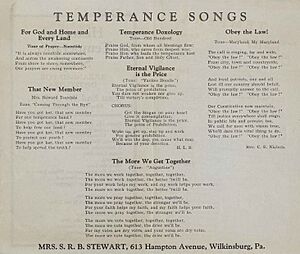
Wilkinsburg was founded by very religious European immigrants. The borough has many churches, mostly Protestant. This is quite unique for a region that is mostly Catholic. In the 1870s, Wilkinsburg avoided being taken over by Pittsburgh partly to keep its religious identity. Because of this, Wilkinsburg was known by many as "The Holy City."
Arts and Culture in Wilkinsburg
Wilkinsburg has a Community Art and Civic Design Commission. This group reviews plans for new buildings, public spaces, and art. Wilkinsburg is also close to Pittsburgh, which offers many art and cultural experiences.
The Wilkinsburg Community Development Corporation (WCDC) helps improve the borough. This non-profit group started in 2007. They work to bring in new businesses and residents. They also support community leaders and celebrate different cultures. The WCDC offers classes for new business owners and people buying homes. They also host community events. Their main focus is the Wilkinsburg Business District.
The WCDC's plan aims for a thriving business area in Wilkinsburg. In 2015, the WCDC helped pass a new law. This law allowed up to five restaurants in the borough to sell alcohol. Before this, Wilkinsburg had been a "dry" community since 1935.
Library Services
The Wilkinsburg library started in 1899. It was a branch of the Braddock library. The Braddock library was the very first of the Carnegie libraries in the United States.
Parks and Recreation
Wilkinsburg has several parks. The biggest is Hunter Park, which is almost nine acres. It has sports courts, fields, playground equipment, and wooded areas. There are also six smaller parks for residents to enjoy.
Education in Wilkinsburg
In its early days, schooling in Wilkinsburg was all private. Teachers often taught classes in their homes. The Wilkinsburg Academy, founded in 1852, was the start of larger schools. In 1840, the borough adopted the Free Common School Act. James Kelly helped fund the first public school. The number of students grew quickly. By 1910, there were over 4,200 students in six public schools.
Today, the Wilkinsburg School District has two elementary schools: Kelly Primary and Turner Intermediate. Due to money issues, Wilkinsburg's Junior and Senior High schools closed in 2016. Now, older students attend Westinghouse High School in the Pittsburgh Public School district.
Wilkinsburg is also home to the Sister Thea Bowman Catholic Academy. This is a Catholic elementary school. It was formed by combining St. James School in Wilkinsburg and Holy Rosary in Homewood (Pittsburgh). The school is in the former St. James building and teaches children from pre-kindergarten through eighth grade.
Transportation in Wilkinsburg
Wilkinsburg is a hub for different ways to travel. It connects road, rail, and river transportation.
Roadways
Wilkinsburg is located along historic roads. Since 1913, the Lincoln Highway has passed through Wilkinsburg. This historic road stretches from Times Square in New York City to Lincoln Park in San Francisco. In Wilkinsburg, parts of the Lincoln Highway are now Penn Avenue and Ardmore Boulevard. These are also known as State Route 8 and Federal Route 30.
Even earlier, Penn Avenue was part of the Forbes Road. This road was used by British officer John Forbes in 1758. He led a military group to attack the French at Fort Duquesne (later Fort Pitt) during the Seven Years' War. Before that, British officer Edward Braddock built a road in the same area, known as Braddock's Road.
Rail Travel
Wilkinsburg used to have passenger train service until September 14, 1975. On that day, Amtrak stopped service because very few passengers were using it. The last train was the National Limited, which traveled between New York City and Kansas City, Missouri. A commuter train, the Parkway Limited, ran for nine months in 1981 but was also canceled due to low ridership.
Today, Wilkinsburg has two stations on the Martin Luther King Jr. East Busway. These are operated by the Port Authority of Allegheny County:
- Wilkinsburg bus station
- Hamnett bus station
Rivers and Waterways
Historically, the meeting point of the Allegheny River and the Monongahela River was very important for transportation. Before modern roads and railways, traveling by water was even more vital. Wilkinsburg is located between the Allegheny and Monongahela rivers, close to where they join to form the Ohio River. However, Wilkinsburg itself does not directly border either river.
Notable People from Wilkinsburg
- Jonathan Adams, actor known for Last Man Standing.
- Les Biederman, a sports writer and editor for The Pittsburgh Press.
- Frank Conrad, a pioneer in radio broadcasting.
- Charlie Deal, a former professional baseball player.
- Dick Groat, a former professional baseball and basketball player.
- Treyvon Hester, a former professional football player.
- Jon Robert Holden, a professional and Olympic basketball player.
- Kimmarie Johnson, an actress, model, and businesswoman.
- Mike Jones, a wrestler known as "Virgil."
- Bill McKechnie, a baseball player and manager.
- Dunning R. McNair, who served as the Sergeant at Arms of the United States Senate.
- Edward Ormondroyd, an author.
- Bunny Yeager, a photographer and model.
Images for kids
See also
 In Spanish: Wilkinsburg para niños
In Spanish: Wilkinsburg para niños


